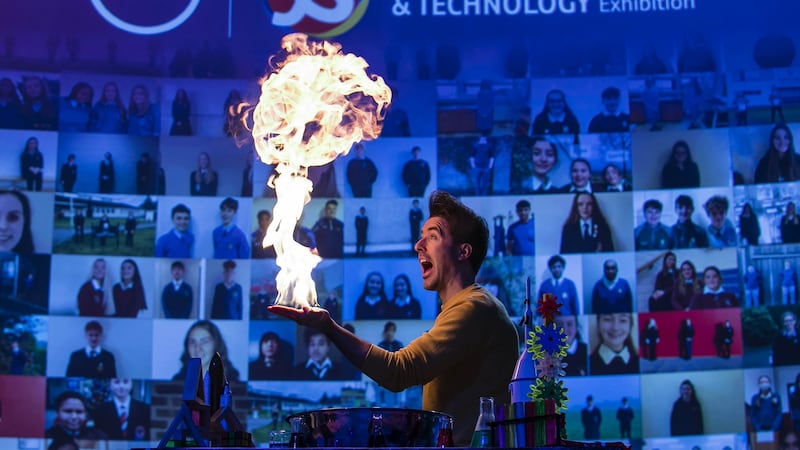Looking at the usual special ingredients of this annual showcase of science by second-level students reveals how challenging it was to turn it into a virtual event due to Covid-19.
In normal circumstances the BTYSTE unfolds over days. More than 1,000 students gather on Tuesday/Wednesday in Dublin’s RDS and quietly put up their projects on display – with expectant teachers and parents hovering nearby. Judging soon begins, and entrants are interviewed by people who are leading researchers and academics in STEM. Big focus is on their research; the approach taken and findings.
Excitement steadily builds as students interact with fellow competitors, dip into some exciting science shows on stage, experience enticing technology on display nearby, and rub shoulders with the odd celebrity or visiting politician.
Most warm up on presentation by outlining the merits of their work in media interviews. The demands of modern science mean it helps to be able to tell a good story with a microphone or camera in your face.
Soon many thousands of public visitors including peers land to quiz them up and down about their endeavours. By Friday, anticipation is heightened in the hall as the final judging takes place amid intense speculation about winners. The following day the public return in their thousands to engage with participants – including the many winners and not just the headline makers.
Covid-19 in the first quarter of 2020 immediately put all that in doubt. Since then, a combination of human endeavour; innovation/ingenuity, and anticipation of the possible vicissitudes of coronavirus kicked in. Technology was added to the mix and made the virtual BTYSTE reality.
In 1968, the exhibition had to be put back until Easter because of a foot-and-mouth disease outbreak, its co-founder Dr Tony Scott recalls. The key difference is "we didn't have the technology we have today".
What were the essential requirements?
The decision was taken as far back as April to go virtual. According to senior judge Prof Pat Guiry, they were analysing the likelihood of Covid waves, and quickly realised a hybrid version would not work. But they never anticipated a third wave as happened in recent weeks which forced the closure of schools, in effect at the last minute.
They knew technology and a robust digital platform were essential to making it happen. So a portal was built with the requirement it have the feel of the RDS including an exhibition zone, a teachers’ area and “stage” for shows, debates and other presentations.
The building of a digital hub-cum-studio in the Mansion House is the key element. Students will engage with their virtual audience via three-minute video presentations.

And what of the judging process?
Rigorous judging which is critical to the integrity of the BTYSTE is exactly the same, Guiry says; each entry will be judged and scored by three judges initially. Winners in key categories are likely to be interviewed up to 15 times to make sure they live up to billing and the usual high standards are applied.
The only difference, he explains, is it's all taking place online using "Meets" technology directly from their homes/offices to students homes. Close to 100 BT workers "accompany" judges to ensure child safety protocols are applied, and all interviews are recorded.
Is the standard of projects undermined by inevitable changes due to Covid?
There are always good abstracts that turn out to be fantastic pieces of research, and those that don’t deliver on early promise, Guiry notes. “It has been a terrible year for young people. But...I’m heartened by the standard of entries. I would say they are as good as ever.”
He accepts, however, that with social distancing requirements, it may have been trying for those doing group projects.
Are there are pluses in staging a virtual BTYSTE?
The pandemic has brought a lot of innovation and changes to the world, points out BT Ireland managing director Shay Walsh. Technology combined with determination, perseverance has enabled a unique event to be staged in spite of big challenges such as new restrictions in recent days.
While he hopes 2021 is a one-off, there are advantages to staging it online. The sharing of documents is much easier, and he believes some shy and retiring students will be less intimidated on a teams call rather than having to sit down with judges in a crowded venue with people milling around close by.
And the technology opens up the BTYSTE to an international audience as anyone can view projects or tune into events by registering for free beforehand.

Is it a true BTYSTE?
This year it may be happening via a virtual platform, but it’s important for young people to realise it’s still the young scientist exhibition that has been sustained for over 56 years, stresses Tony Scott. Though judges are connecting with them virtually, they will be just as interested in listening to details of their research efforts. Overall, “its integrity and modus operandi have been maintained. That is the important thing.”
The north stars in the face of Covid were to stage a viable exhibition and for a young scientist and technologist of the year – or a group as overall winners – to emerge from that, Walsh says. “There was no way it would not take place...A tech company who cannot organise an online exhibition is not much of a tech company.”
Guiry adds: “We wanted it to be a beacon of hope, of light, even if everything else is off. With schools closed, I think it will be great for families looking for something to do this week.”
Detail of events and how to register are available at www.btyoungscientist.com or via @BTYSTE on Facebook, Instagram, Twitter, YouTube or Snapchat username: BTYSTE











